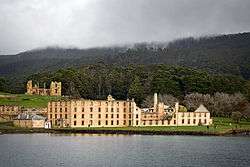Tasmania
Tasmania is an island state of Australia south east of the mainland. It is the smallest state in Australia by size and by population.
The Bass Strait has isolated Tasmania from the mainland for thousands of years which has resulted in some truly unique flora and fauna. You'll find the inhabitants notably more polite, friendly and helpful than in big cities such as Melbourne and Sydney.
Regions
| Southeast Tasmania (Hobart, Bruny Island, Cygnet, Huonville, Port Arthur, Richmond) The most populous region of Tasmania. Hobart is Tasmania's capital and largest city. Hobart is also the second oldest city in Australia. |
| Northeast Tasmania (Launceston, Ben Lomond, Bridport, Campbell Town, George Town) This area encompasses the city of Launceston and the Tamar Valley, the mountainous region of Ben Lomond, the Midlands, and the North East. |
| North West Coast (Stanley, Wynyard, Somerset, Burnie, Devonport, Cradle Mountain, Latrobe) Small coastal townships and cities following the coast. And some very scenic inland areas. |
| East Coast (St Helens, Bicheno, Scamander, Swansea, Freycinet Peninsula, Maria Island) Stunning beaches including the Bay Of Fires and Wine Glass Bay, voted some of the most beautiful beaches in the world. |
| West Coast (Queenstown, Strahan) The West Coast has long been the centre of mining in Tasmania, with a small population |
| South West This whole region is protected inside the South West National Park. |
| Bass Strait Islands (King Island, Flinders Island) The two secluded but very scenic islands in the Bass Strait between Tasmania and mainland Australia. |
Cities and townships
- 🌍 Hobart – the state capital and largest city located in the south of the island
- 🌍 Bicheno – beach town on the east coast
- 🌍 Burnie – the fourth largest city in Tasmania
- 🌍 Devonport – home to the Spirit of Tasmania ferry, third largest city
- 🌍 Huonville – gateway to southern Tasmania
- 🌍 Launceston – the second largest city
- 🌍 Queenstown – historic mining town on the west coast
- 🌍 Richmond – home to many old buildings dating back to the 19th century as well as the oldest bridge in use in Australia
- 🌍 Scottsdale
- 🌍 Strahan
Other destinations
- 🌍 Bruny Island – perhaps Tasmania's most visited island
- 🌍 Cradle Mountain – one of Tasmania's most iconic landmarks and also the starting point of the Overland Track
- 🌍 Huon Valley – lush countryside and gateway to the south
- 🌍 The Nut at Stanley – an ancient volcanic plug
- 🌍 Port Arthur – former convict settlement
- 🌍 Tasman Peninsula – stunning coastal scenery
National parks
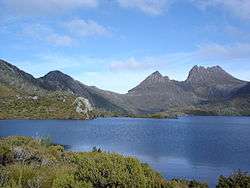
Tasmania has some of the most beautiful and diverse scenery not just in Australia but also the world. Over 45 percent of Tasmania is protected in national parks so you can't make a visit here without checking at least a couple of national parks out. The UNESCO World Heritage site Tasmanian Wilderness covers almost 20% of Tasmania. There's a park for every season and for every person. Discover spectacular landscapes from highlands carved by glaciers, to quiet solitary beaches, from cool and silent rainforests, to colourful alpine wilderness wild flowers. Tasmania's 19 national parks encompass a diversity of unspoiled habitats and ecosystems which offer refuge to unique, and often ancient, plants and animals found nowhere else on Earth.
- 🌍 Ben Lomond National Park – Mountain with a ski resort.
- 🌍 Cradle Mountain-Lake St Clair National Park
- 🌍 Franklin-Gordon Wild Rivers National Park
- 🌍 Freycinet National Park
- 🌍 Mole Creek Karst National Park
- 🌍 Mt Field National Park
- 🌍 South West National Park – Tasmania's largest national park in the south-west of the island.
Understand
Geography
Located in the Southern Ocean separated from mainland Australia by the Bass Strait and from New Zealand by the Tasman Sea. Australia's smallest state, with an area of 68,400 km² (26,410 square miles). It is comparable in size to the United States state of West Virginia or the country of Ireland. It's within the range of the notorious "Roaring Forties" winds that encircle the globe.
Tasmania's population is focused in the southeast and north in the regions around the cities of Hobart and Launceston.
The Midlands (the area between Hobart and Launceston) is the driest region of Tasmania and is primarily used for cattle and sheep grazing. The Huon Valley and the area between Launceston and Burnie is used for both agriculture and horticulture. The Central Highlands, the West Coast and the South West are all mountainous forested areas, a majority of which are protected inside national parks.
Tasmania is very mountainous, and its tallest mountain is Mount Ossa at 1,617 m (5,305 ft). Much of Tasmania is densely forested, with the South West National Park and neighbouring areas home to some of the last temperate rain forests in the Southern Hemisphere.
Climate
| Hobart | ||||||||||||||||||||||||||||||||||||||||||||||||||||||||||||
|---|---|---|---|---|---|---|---|---|---|---|---|---|---|---|---|---|---|---|---|---|---|---|---|---|---|---|---|---|---|---|---|---|---|---|---|---|---|---|---|---|---|---|---|---|---|---|---|---|---|---|---|---|---|---|---|---|---|---|---|---|
| Climate chart (explanation) | ||||||||||||||||||||||||||||||||||||||||||||||||||||||||||||
| ||||||||||||||||||||||||||||||||||||||||||||||||||||||||||||
| ||||||||||||||||||||||||||||||||||||||||||||||||||||||||||||
| Queenstown | ||||||||||||||||||||||||||||||||||||||||||||||||||||||||||||
|---|---|---|---|---|---|---|---|---|---|---|---|---|---|---|---|---|---|---|---|---|---|---|---|---|---|---|---|---|---|---|---|---|---|---|---|---|---|---|---|---|---|---|---|---|---|---|---|---|---|---|---|---|---|---|---|---|---|---|---|---|
| Climate chart (explanation) | ||||||||||||||||||||||||||||||||||||||||||||||||||||||||||||
| ||||||||||||||||||||||||||||||||||||||||||||||||||||||||||||
| ||||||||||||||||||||||||||||||||||||||||||||||||||||||||||||
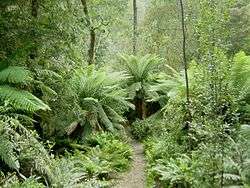
Tasmania typically has more rainy days than anywhere else in Australia, with "four seasons in a day" being often the norm. The South West and West Coast in particular receive a great amount of rainfall - so much of it that it is considered uninhabitable. Both cold waves from Antarctica and heatwaves from Australia can reach the island anytime. The sea temperature is rather low throughout the year, even at the north.
Tasmania has a cool temperate climate with the following seasons:
- Spring from September to November, with frequent snowfalls.
- Summer from December to February. It has about 15 hours of daylight from 05:30 - 21:00.
- Autumn from March to May. Changeable weather.
- Winter from June to August. High areas receive a good amount of snowfall. It has the least daylight with about 9 hours a day from 08:00 to 16:30.
History
The first reported sighting of Tasmania by a European was on 24 November 1642 by the Dutch explorer Abel Tasman. Captain James Cook landed at Adventure Bay in 1777. Matthew Flinders and George Bass first proved Tasmania to be an island in 1798–99.
The first European settling of Tasmania was by the British at Risdon Cove on the eastern bank of the Derwent estuary in 1804. Penal settlements were established at Sullivans Cove (Hobart), Maria Island, Sarah Island, and Port Arthur. The colony changed its name from "Van Diemen's Land" to "Tasmania" in 1856. The Colony of Tasmania existed from 1856 until 1901, when it federated with the five other Australian colonies to form the Commonwealth of Australia.
Economy

Tasmania's main industries are mining (including copper, zinc, tin, and iron), forestry, agriculture, fresh produce (fruit, vegetables, dairy, seafood, beer and wine), and tourism. The economy is affected by the Bass Strait, and how the freight and transport issues of goods into and out of the island are costed and subsidised, at times there are more Tasmanian-born people in Melbourne, than there are in Tasmania, due to the nature of the Tasmanian job market.
Holidays
National Public Holidays can be found in the main Australia article.
Statewide Public Holidays
- 8 Hour Day : Second Monday of March (Labour Day)
- Recreation Day : First Monday in November (Except Hobart)
Regional Public Holidays These apply to smaller areas of Tasmania:
- Wednesday not earlier than fifth and not later than eleventh day of January: Devonport Cup
- Last Wednesday of February: Launceston Cup
- Second Monday of February: Royal Regatta Day (Southern Tasmania only)
- First Tuesday of March: King Island Show
- The Friday nearest the last day of November: AGFEST (Circular Head only)
- The Friday before the first Saturday of October: Burnie Show
- Thursday before the second Saturday of October: Royal Launceston Show
- The Friday before the third Saturday of October: Flinders Island Show
- The Friday before the third Saturday of October: Royal Hobart Show
- The Friday nearest the last day of November: Devonport Show
Time zone
Tasmania is 10 hours ahead of Greenwich Mean Time and 18 hours ahead of Pacific Standard Time (PST). Daylight Saving is observed from the first Sunday of October to the first Sunday of April the following year.
AEST - Australian Eastern Standard Time UTC+10
AEDT - Australian Eastern Daylight Saving Time UTC+11

|
Tasmanian devils This carnivorous marsupial is the size of a small dog and found only in Tasmania. The largest carnivorous marsupial in the world, it is characterised by its stocky and muscular build, black fur, extremely loud and disturbing screech, and ferocity when feeding. Despite its appearance, the devil is capable of surprising speed and endurance and can climb trees and swim across rivers. Since the 1990s, a deadly disease, devil facial tumour disease, has drastically reduced the devil population and now threatens the survival of the species, which in 2008 was declared to be endangered. The disease is a transmissible cancer, which means that it is contagious and passed between animals when fighting, causing individual devils to die within months being infected. Programs are being undertaken to reduce the impact of the disease, including an initiative to build up isolated colonies of healthy devils in captivity. As of 2008 there were an estimated 10,000–15,000 remaining in the wild, but the decline is so rapid that they are predicted to become extinct before the year 2035. There are people that wish to take a more genetically resistant strain from the North West of Tasmania and introduce them to areas of mainland Australia where there are no dingoes in order to reduce feral cats and foxes and allow a better chance of survival for Australian native animals. |
Get in
By plane
There are no international scheduled flights to Tasmania. All flights must come through mainland cities. There are seasonal flights over Antarctica.
- Flights to Hobart from Melbourne, Sydney, Brisbane, and the Gold Coast.
- Flights to Launceston from Melbourne, Sydney and Brisbane.
- Flights to Burnie and Devonport from Melbourne.
- Flights to King Island and Flinders Island from Melbourne.
See the local guides for more information.
By ferry
There is only one ferry route, which are the two Spirit of Tasmania Ferries from Station Pier in Port Melbourne in Melbourne and arrive at Devonport. See the Devonport article for the details of the ferry. It takes a full night (or the full day during peak summer periods) for the crossing and take vehicles, bikes, foot passengers and pets.
The crossing can be a little choppy at times, but provides beautiful views and costs around $200 each way. You have the option of booking one of a range of a cabins or a reclining chair for the journey.
Crossings can also be part of cruise ship itineraries.
Rental car companies usually have restrictions on taking vehicles into or out of Tasmania on the ferry. If you have hired a car on the mainland and need a car to hire in Tasmania, it's best to drop the car off in Melbourne CBD (there is no hire car dropoff at Station Pier), then take the 109 tram out to Station Pier (the terminus is across the road from the ferry terminal); car hire is available at the Devonport terminal.
There is no ferry service between New Zealand and Tasmania (or indeed anywhere else in Australia).
Get around
By car
Driving is the most convenient way to get around. Cars can be brought into Tasmania from Melbourne on the Spirit of Tasmania ferry, or hired upon arrival through the major operators such as Redspot Sixt, Europcar, Hertz and Avis. Car rentals typically do not permit taking the car on the ferry crossing.
The state speed limit is 110 km/h although Tasmania has a number of roads where the speed limit is 90 km/h or below. Many major roads wind their way through mountain passes and along coastlines, with few overtaking lanes, and some sections of remote roads may be in need of repair. Direct roads on the maps may take longer than you think. Take care on some of the winding or secondary roads, since some locals may try to overtake on dangerous stretches of road or tailgate you if you aren't travelling fast enough. Some local drivers, especially in suburban and semi-open areas (e.g. Bass Highway), will also tailgate and attempt dangerous manoeuvres to pass or overtake you, especially if they see you are diving a hire car.
Exploring the forests can often lead to a maze of forest roads. A GPS can come in handy for finding your way out, although they are not always up to date.
Indicative travel times are :
- Hobart to Launceston: 2hr 20min (199 km)
- Hobart to Devonport: 3hr 30min (279 km)
- Hobart to Cockle Creek: 2hr 10min (117 km)
- Hobart to Stanley: 4hr 30min (402 km)
- Hobart to Queenstown: 3h 40min (259 km)
By bus
Buses can be an option if time is on your side. Planning is advised since services can be infrequent. Redline Tasmania and Tassielink are the main long distance bus companies, with population centres serviced by Metro Tasmania for Burnie, Hobart and Launceston and Merseylink that provide services to Devonport and Latrobe. If you are not in a major town (e.g. Hobart, Launceston) bus services can be infrequent, expensive and hard to rely on. Make sure you have a copy of the timetable with you.
By train
There are no public train services.
The West Coast Wilderness Railway is a tourist train which runs between Strahan and Queenstown on the West Coast. The trip takes about 3 hours with lunch included.
By plane
- Par Avion offer scenic flights across the state and services into Melaleuca in the Southwest National Park.
- Airlines of Tasmania offer flights between Launceston and Cape Barren Island.
- Sharp Airlines offer flights to Flinders Island from Launceston and flights to King Island from Launceston and Burnie.
By bicycle
Bicycle touring is a popular way to see Tasmania.
See
Wildlife
- See also: Australasian wildlife
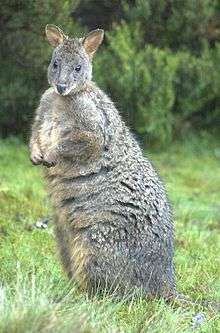
If you spend any time in the bush you are very likely to see:
- Kangaroos, wallabies, and pademelons are everywhere throughout Tasmania.
- Wombats can be found in many national parks and mostly come out at night.
- Ringtail and Brushtail Possums only come out at night.
Less common wildlife include:
- Echidnas are rarely seen in the bush. They're more easily spotted when crossing roads.
- Bandicoots and Potoroos are at the small end of the jumping marsupial scale.
- Platypus are very elusive. If you are persistent and very quiet and still you may find one rummaging at the bottom of a creek.
- Eastern and Spotted-tail Quolls very rarely seen.
- Tasmanian Devils are rarely seen in the wild. They can sometimes be spotted along roadsides eating roadkill at night.
Landmarks
- Bay of Fires is one of Tasmania's most popular tourist destinations, located between Eddystone Point and Binalong Bay. Bay of Fires has beautiful blue water, red rocks, and sandy white beaches. Enter through Binalong Bay which is 10 minutes from St Helens. This area offers a wide range of activities including camping, boating, bird watching, fishing, swimming, surfing, and walking along the coastline.
- Cataract Gorge is a unique, natural formation within a two-minute drive from central Launceston known to locals as The Gorge. After walking 15 minutes from central Launceston along Tamar River into Gorge, you then follow the pathway along the cliff face looking down onto South Esk River. On the southern side, called the First Basin, there is a cafe, swimming pool, and Launceston's beach. The northern side, known as the Cliff Grounds, there is a kiosk, restaurants, swimming pool, and a chairlift across the river. The Cataract Gorge Reserve is one of Australia's most fascinating urban parks.
- Hastings Caves include Newdegate Cave, the largest cave in Australia open to tourists. Tour magical chambers of flowstones and shawls, then relax in a thermal pool. Formations in the cave are spectacular and include flowstone, stalactites, columns, shawls, straws, stalagmites and the unusual helictites - tendrils of calcite that grow in all directions in tiny filaments.
- Mole Creek Karst Australia's only national park featuring caves. Among many features are the King Solomon and Marakoopa Caves, both of which can be viewed with Tasmania Park Service guides leading you. Both caves are distinctly different and a separate entry ticket is required for each. Tour times are staggered throughout the day.
Five world heritage listed convict sites are located in Tasmania, in the Northeast and Southeast of the island. The best known is likely Port Arthur.
- Port Arthur is the best preserved convict site in Australia. Many years ago, this site was a key role in the colonial system of convict discipline. During your experience, you will have the chance to take guided tours of the Commandant's House, Parsonage, Trentham Cottage, Junior Medical Officer's quarters, historic buildings and ruins of the Penitentiary, Barracks, Guard Tower and military precinct, Hospital, Paupers' Depot and Asylum. Port Arthur is surrounded by beautiful bushland and trails available to explore the land around you.
- Salamanca Place in Sullivans Cove, is Hobart's favourite hang out. Salamanca is lined with a long row of sandstone buildings built in the 1830s. You can wander under the heavy stone arches to find craft and design shops, jewellers, coffee shops, restaurants, bookshops, fashion boutiques, and the Salamanca Arts Centre and artists’ galleries. Every Saturday there’s the Salamanca Market, where you can buy anything from a handmade wooden toy or a hand-spun, hand-knitted sweater to fresh fruit and vegetables or a 50-year-old china plate.
- The Nut is located at the historic village of Stanley, in far north-west Tasmania. The Nut, a sheer-sided bluff is all that remains of an ancient volcanic plug. A walking track climbs to the summit of The Nut, or you can take the chairlift, with spectacular views across Bass Strait beaches and over the town. There is accommodation and an excellent campground in Stanley, and the town is a good base for exploring the forests and coastlines further west.
Do
- Trout fishing. Trout Guides and Lodges Tasmania Incorporated (TGALT) is the industry body, that was voluntarily formed in 1981 as the Tasmanian Professional Trout Fishing Guides Association. Its primary purpose was to provide anglers with a source of guides that they could be assured, would provide a safe, appropriate and professional service. During 1995 the Association was expanded to specifically include trout fishing lodges as full members.
- The Overland Track. The iconic bushwalk from Cradle Mountain to Lake St Clair - bookings essential during the main walking season (November to April).
- The South Coast Track. The bushwalk along the south coast of Tasmania, from Melaleuca, to Cockle Creek - fly in by aircraft and take a 6-day walk back home
- The Great Tasmanian Bike Ride - held in early February.
- Bicycle touring and mountain biking - there are some great places to ride your bicycle in Tasmania.
- Scuba diving - Tasmania is home to some of the best temperate diving in the world. Along with its giant kelp forests and numerous shipwrecks, the waters reefs also offer an array of unique marine plants and animals. There are many dive sites along the coast, the most popular sites are at Bicheno, Bay of Fires, Flinders Island, Fortescue Bay, Tasman Peninsula and Maria Island.
- Off road touring - Tasmania is a very rugged and heavily forested region, tourists happen to miss out on some incredible places if they do not have a vehicle with four-wheel-drive. Visitors can explore these trails with an experienced operator or either form or tag along with a group. Before exploring, make sure you have a current map of the area. In 2003, Tasmania changed the co-ordinate system used for all maps from AGD 66 to GDA 94. Also, ask the local land manager for the latest information on the condition of the area you plan to use and permits.
- Wildlife watching. Because of its separation from mainland Australia, Tasmania is home to many of the animals or plants that are rare or even extinct in other areas around the world. If visitors are watchful, they are very likely to witness these species on trails or near streams. Tourists can also be by a tour guide to point out these animals so you won't miss them! Some of these rare mammals include the Tasmanian Devil, Platypus, Echidna, Sugar Glider, Eastern Quoll, and Forester Kangaroo.
- Hang gliding and the Flying Fox. Hollybank Treetops Adventure takes visitors across treetops and gives them the experience of seeing Tasmania's forests in a whole new way - bird's-eye view! These canopy tours last for 3 hours and are led by highly trained professionals. Not only do guests take part in this unique adventure by soaring across about a kilometre of cable but they also learn about the forests below them.
- Kayaking. After landing in Hobart's Airport, you are a mere 20 minute drive away from beginning your kayaking experience. Visitors can explore Tasmania's beautiful coastlines and search out secret coves by kayaking. There are professional kayak guides based in Hobart, Kettering, Port Arthur, Coles Bay, Launceston, and Strahan. Kayak travel through Tasmania's beautiful landscape offers relaxation and exhilaration that tourists will not want to miss out on.
- Adventure activities including abseiling, all-terrain vehicles, bicycle touring, caves and caving, diving, jet boats, kayaking, mountain biking, rock climbing, skiing, sky diving, swimming, surfing and whitewater rafting
Eat
There are a wide variety of culinary offerings in Tasmania, from the best chips and gravy at the local milk bar, to world renowned chefs.
There is a list of vegetarian and vegetarian friendly eateries in Tasmania.
In addition you can try seafood such as salmon, abalone, scallops, oysters, mussels and crayfish.
Drink

Tasmania has many exceptional world class beers, whiskies & wines.
There are two major breweries in Tasmania; Cascade Brewery in Hobart and J. Boag & Sons Brewery in Launceston, which each offer tours. A number of boutique beer makers and distillers are spread around the state.
You can tour the Tasmanian Wine Routes easily by car or on guided tours. The island's Wine Routes include the Tamar Valley, north of Launceston along both sides of the Tamar River and east to Pipers River; the Derwent, Coal River and Huon Valleys (together comprising the Southern Wine Route), an easy drive from Hobart; and the growing wine regions of the North West and the East Coast.
Sleep
There is a variety of accommodation options available across the state, from camping through to 5-star luxury. Tasmania is particularly renowned for its hosted bed and breakfast accommodation where you can experience a different way of life in a whole range of different properties, including heritage listed and more modern properties in stunning locations.
There are four YHA (Hostelling International) branded hostels in Tasmania and a number of independent operators spread around the state. Prices range anywhere from $10-30.
Respect
Tasmanians are generally more laid-back and friendly than their mainland counterparts. They are usually very willing to help you out or give advice when asked.
Stay safe
While driving
Road rules are simple: 50 km/h on all Tasmanian streets, 110 km/h on highways and 100 km/h country roads unless otherwise signposted. Many of Tasmania's country roads are narrow and windy and some local drivers can be very dangerous, especially if they know the road and you don't. Be especially careful driving between dusk and dawn as this is when the wildlife is most active, keep on the lookout for wallabies, rabbits, possums and others. Be prepared to see a lot of roadkill. Wallabies and wombats can make a mess of your vehicle if hit.
In the bush
Bushwalking can be a truly breathtaking experience in Tasmania, but be sure to obtain the right gear, local advice and maps. Always sign the logbook at the beginning and end of each walk. Be aware that mobile coverage is limited in wilderness areas. The main dangers of bushwalking are getting lost and/or suffering from hypothermia. Tasmania's weather is notoriously changeable. Be sure to take a good raincoat and warm clothes with you even on a sunny day because an hour or two later it could be pouring with rain. If undertaking more serious bushwalking a map and compass is a must, as is a good sleeping bag and tent for multi-day walks.
Mosquitoes are present all year round. There are no mosquito-born viruses. A good repellent is advisable if going into the bush.
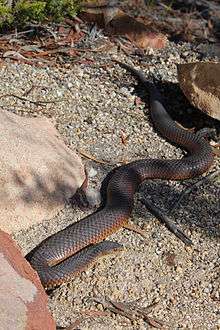
Wildlife
There are three species of snake in Tasmania: copperhead, white-lipped, and tiger. The tiger snake is one of the most venomous snakes in the world, but don't let that deter you. No one has died from a snake bite in Tasmania since 1977. All three use the same anti-venom so identification of the snake is not important. Most snakes will slither away as soon as they hear you coming.
Water
While in wilderness areas the water may be good to drink, but it is still highly recommended that you boil before consumption. If in touristy areas, such as The Overland Track, always boil your water or risk gastro.
Go next
- Melbourne is an obvious next destination, easily reachable by ferry or plane.
- Antarctica from Hobart has scheduled flights during summer months
